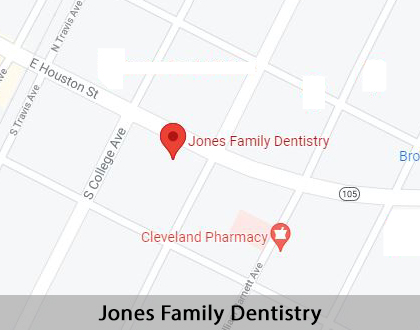Emergency Dental Care Cleveland, TX
When someone is suffering from severe pain or other serious dental issues, emergency dental care may be needed. Although many people experiencing oral issues can wait to schedule a regular appointment with their dentist, some situations require immediate treatment. Emergency dental care is necessary in certain acute situations and can stop severe pain, prevent chronic issues, and even save an individual’s life.
Emergency dental care is available at Jones Family Dentistry in Cleveland and the surrounding area. It may be difficult to understand what constitutes an emergency when it comes to dental problems. However, there are certain signs that indicate when someone should pursue more immediate care.
Ignoring a dental issue can have long-term consequences and can affect other teeth, the gums, or the underlying jaw bone. Knowing when a regular or emergency visit should be made can help control the problem more efficiently. Call us at (281) 205-5392 if you have dental questions and are unsure whether you should seek emergency treatment.
When To Seek Emergency Dental Care
Like a number of other health conditions, the American Dental Association states that a dental emergency can be life-threatening. Serious issues that need immediate attention include infection and ongoing bleeding. Certain traumas, especially those that involve facial bones, also require immediate treatment, as they can cut off the airway and restrict breathing. Seeking immediate dental attention for these issues can prevent trips to the ER at the hospital.
Uncontrolled bleeding and difficulty breathing are not the only reasons to get emergency care. There are numerous other urgent dental conditions that indicate an appointment should be made right away. Some of these issues and their symptoms include:
- Infection: Infection can be caused by numerous things, and it can be localized or more general. Common signs include swelling, red gums, pain, and pockets of pus. An infection may also result in a fever.
- Pulpal inflammation: According to Medical News Today, this is inflammation of the pulp, which refers to the tissue, blood supply, and nerves found in the middle of a tooth. It is often caused by a cavity infection and often is indicated by sensitivity, swelling, and pain.
- Dry socket: Dry socket can occur after the removal of the tooth, most commonly a wisdom tooth. It occurs when a blood clot becomes dislodged or does not form properly, which exposes the bones and nerves in the gums. Throbbing jaw pain, bad breath, and an unpleasant taste in the mouth are all possible symptoms.
- Tooth fracture: A fractured tooth can occur from an acute injury or from biting something hard. A fracture may be easy to spot if it is an obvious break. Additional signs to watch for are pain, temperature sensitivity, and swelling.
“Serious issues that need immediate attention include infection and ongoing bleeding.”
What Procedures Emergency Dental Care Covers
The specific type of procedure used is largely dependent on the symptoms and issue. For infections, the dentist acts to fix the problem, such as removing decay from a lost filling, and then possibly prescribes an antibiotic to kill off the harmful bacteria. Pulpal inflammation may be caused by a cavity, injury, a fractured tooth, or repetitive trauma. Potential procedures used include disinfecting and sealing or removing the tooth.
For a dry socket, Healthline describes that the dentist cleans the socket to prevent infection and ease the pain and then pack it with gauze. Often pain medication is recommended to provide relief. Depending on the severity of a fractured tooth, common procedures include bonding, placing a crown, root canal, or extraction.
“The specific type of procedure used is largely dependent on the symptoms and issue.”
Non-Emergency Issues
Certain signs that indicate potential emergency situations are also signs of non-emergency ones. Therefore, if there is any doubt, it is still a good idea to make an immediate appointment. Bleeding is one example. Although some bleeding after a dental procedure is normal, it should only last around 24 to 48 hours, in most cases. If the bleeding is intense and uncontrollable, it is a good idea to visit the dentist right away.
Some dental emergencies are nonurgent and can wait a day or two to be seen. These include a small crack or chip in a tooth; a lost crown, filling, or bridge; a dull toothache; and food stuck between two teeth.
“Certain signs that indicate potential emergency situations are also signs of non-emergency ones.”
Check out what others are saying about our dental services on Yelp: Emergency Dental Care in Cleveland, TX
When Pain Occurs
Pain is another common sign of various dental issues that can range from minor to serious. If the pain is dull, intermittent, or both, it is probably all right to wait for a regular appointment. However, pain that is sharp and constant indicates an emergency, so it is recommended to make an immediate appointment even if there are no other signs. WebMD also states that jaw pain can also be a sign of more serious dental issues.
“However, pain that is sharp and constant indicates an emergency, so it is recommended to make an immediate appointment even if there are no other signs.”
Questions Answered on This Page
Q. When should one seek emergency dental care?
Q. What procedures are performed under emergency dental care services?
Q. What non-emergency issues should still be examined?
Q. Why should patients seek professional dental care in cases of emergency?
People Also Ask
Q. When should I go straight to the emergency room
Frequently Asked Questions
Q. What are the main goals of emergency dental care?
A. In general, there are three main goals for immediate treatment. One is to relieve pain. Another is to save any teeth in danger, and the third goal is to stop or prevent infection.
Q. Why is a dental infection considered an emergency?
A. Untreated infection can quickly result in serious problems. An oral infection requires immediate dental care because the infection can spread to other areas of the body. Swelling, pain, nausea, fever, and pockets of pus indicate that emergency care is required right away.
Q. Is a cut inside the mouth an emergency?
A. A cut may or may not need emergency attention. The area should be cleaned, and the bleeding should stop with gauze and pressure. However, if the cut is large and the bleeding does not stop, the person may need emergency dental care.
Q. If a temporary restoration falls off, do I need emergency dental care?
A. It depends on how it happened. Denture adhesive may be used to fit the restoration back in place until a regular appointment is made. However, if trauma caused it to fall out and there is pain and bleeding, it is an emergency.
Q. Will a patient still need to make a regular appointment?
A. Emergency dentists do everything they can to fix an acute situation. However, along with emergency dental care, the patient will probably need to make a regular appointment for additional treatment. Even if additional procedures are not necessary, a follow-up dental appointment is usually required.
Quality Dental Services Can Transform Your Smile
By visiting us as soon as possible, our team can help get you the professional treatment you need. Instead of waiting around and allowing the symptoms to get worse, we can provide you with treatment options.
Dental Emergency Terminology
Call Us Today
Fast care for a dental emergency can be crucial. If in doubt about whether you are experiencing a dental emergency, call us at 281-205-5392 for an appointment in our Cleveland office.
Helpful Related Links
- American Dental Association (ADA). Glossary of Dental Clinical Terms. 2021
- American Academy of Cosmetic Dentistry® (AACD). Home Page. 2021
- Colgate®. Lost Filling Or Crown. 2021
- Orajel™. Toothache & Denture Pain Relief. 2021
- WebMD. WebMD’s Oral Care Guide. 2021
About our business, license, and website security
- Jones Family Dentistry was established in 1994.
- We accept the following payment methods: American Express, Cash, Check, Discover, MasterCard, and Visa
- We serve patients from the following counties: Liberty County and Montgomery County
- We serve patients from the following cities: Cleveland, Conroe, Livingston, Glendora and Porter
- TX (License #17671). View License Information and Specifics
- National Provider Identifier Database (1457408031). View NPI Registry Information
- Healthgrades. View Background Information and Reviews
- Norton Safe Web. View Details
- Trend Micro Site Safety Center. View Details
Back to top of Emergency Dental Care








